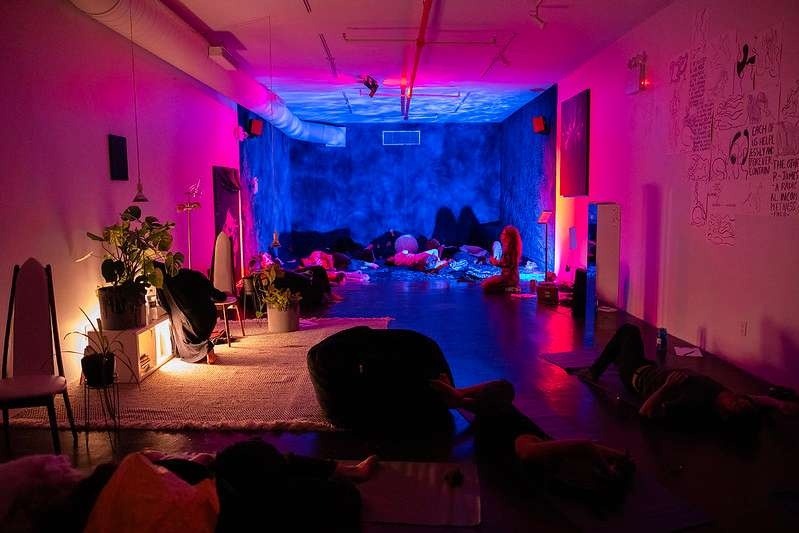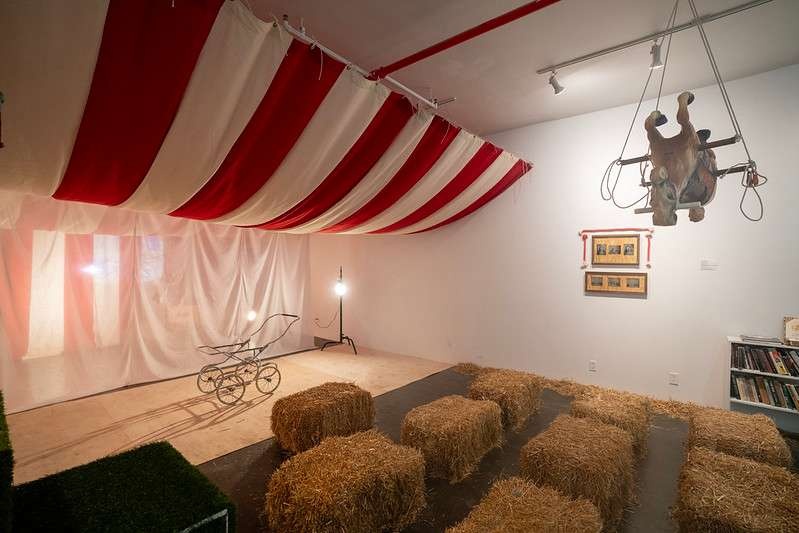I.
AMBUSH
“Kromanti.”
The first time I heard this word was in the Spring of 2014. An Andy Warhol Curatorial Fellow, I journeyed to Pikin Slee, a maroon village established over two centuries ago, in the heart of the Suriname rainforest, in search of Africa in the Dutch Caribbean. What I found was Ghana, as if in a suspended state, yet in the midst of modernity. Black women were walking around bare breast with lapas wrapped around their waists, baskets balanced atop their heads and cellphones in their hands. What I also learned was that the Yaw Kromanti—a group of Winti, deities in Surinamese cosmology—a derivative of Akan traditional religion from Ghana, are alive and well. Prior to leaving Paramaribo, on a trek that would entail driving two hours through the dense South American country by car and then making our way one and half hours up river in a narrow wooden boat run by a simple motor, I’d already found deep Diasporic bridges between Ghana’s Ashanti people and Suriname’s maroon and Creole populations. That is our (duty), those of us who do Diaspora work, to constantly connect dots between the Continent and the west, linking past and present, here and there through space and time.
“I’m reading about ambush,” Kleaver’s text told me. I asked him to elaborate. “This book I’m reading attributes the maroons in Jamaica to creating camouflage, though they called it ‘ambush’.” Kleaver, my friend and accountability partner, a Black Dominican and queer writer, is as interested in Diaspora work as I am.
“Can you take a picture of that passage?” I asked him. He sent several.
“The Spaniards searched in vain for the runaways. However, the Koromanteens completely escaped detection for they were quite adept at blending with the forestation by employing that African disguise the ‘ambush’ (the maroons misunderstood the literal British usage of the word and instead used it to indicate the actual dress of greenery they wore to camouflage themselves in battle).”1
Queen Nanny, the Akan priestess who valiantly led Jamaican maroons in a war against the British was not only well-skilled in the art of combat, but also ambush. Concealment. Camouflage. Guerrilla warfare tactics that would not be adopted en masse by Europeans for another hundred years. Maroons in Jamaica were not the only ones to employ these tactics. So did the maroons of Suriname who have successfully fought against the Dutch since the 17th Century.
Kromanti or Koromanteen refers to the groups of Africans who were captured, enslaved, and brought through the Dutch Fort Cromantine on slaves ships in the Trans-Atlantic slave trade to the New World. The term referred specifically to a group of Fante speaking people, including the Ashanti who were known to be some of the fiercest warriors in all of West Africa.
The fought valiantly, bravely; they fought hard.
Was is it a coincidence that maroons of Suriname were also skilled in ambush and guerrilla warfare? That they too were once enslaved Africans, largely from the Ghanaian Gold Coast, who instead of facing an uncertain future in the bondage of one of the most brutalizing institutions of slavery in the New World, opted to runaway to forge an existence for themselves in the thick rainforest? And that when their freedom was challenged by plantation-owning Europeans seeking to regain their property, they engaged in guerrilla warfare and ambush tactics? Ghana, Jamaica, Suriname. Kromanti. It’s not surprising that two of the largest groups of Akan descendants established maroon settlements that have survived both slavery and colonization in the West.
Whether or not the art of modern camouflage itself, as well as concealment and guerrilla warfare, can be attributed to enslaved Africans who waged war against Europeans in the Caribbean and South America can be debated. What we do know for certain, however, is that it was indeed a tactic mastered by Black rebels, fighting to regain their freedom in a foreign, hostile land, far away from home…Africa.
II. RAZZLE DAZZLE
“It is far better to employ intelligence and concealment, so as to induce him to present a target. A man who is well concealed can bide his time, watch for the enemy to expose himself and hold his fire until his target is sufficiently close to make sure of it. In this way the Home Guard may be able to destroy the invader without even allowing him the chance to hit back. By good concealment it will greatly augment its value as a fighting force. Camouflage is no mystery and no joke. It is a matter of life and death-of victory or defeat.” – Roland Penrose, Home Guard Manual of Camoflauge2
Razzle Dazzle Camouflage was a highly innovative military strategy employed during the height of World Wars I and II that entailed deploying battle ships that had been painted in contrasting black and white geometric forms by surrealist and cubist artists. The theory was that instead of relying on concealment, these ships would confuse the enemy targets who would be unable to determine the ships’ size, speed, and the direction in which they were heading. They therefore weren’t hidden…
They stood out.
Like the African-American and Chicano zoot suiters. At the same time that they were seeking refuge within insular spaces, zoot suiters were still hyper-visible in an oppressive white society and thus, their enemies. Perhaps that has always been the point. The exaggerated, ostentatiousness of zoot suits were created and worn, not necessarily to bring attention to the Black body per se, but to the idea of Blackness in contrast to that which was established and maintained within the white imagination.
They intentionally aspire to confound the beholder.
Like Black and Brown zoot suiters have historically confounded dominant white society. For more than seven years now I have been engaged in the sartorial discourse trenches, but never have I considered the zoot suit in the same way that I have about other forms of Black dandyism and suiting up. If I did, I did so only in juxtaposition to what quintessential dandyism is not.
Zoot suiting, was/is something else.
However…
Despite my inability or reluctance to locate it firmly within the historical framework of dandyism, what I cannot dispute or deny is its placement within the lineage of ticksterism.
African trickster culture, motifs, and influences throughout the African diaspora have afforded New World Africans some sense of safety and protection. A trickster plays on the optics of those who would come in contact him. So does the zuit sooter.
Why?
Perhaps to elevate their social/economic/educational status. Perhaps to dismantle that pre-existing one.
III. SEEN
During the Read My World Literary Festival, an annual international celebration of words and letters that I happened to curate with fellow New Orleanian Maurice Ruffin this Fall, I remember poet Rickey Laurentiis stating his discomfort with academic and activist commentary about Black bodies. It was as if humanity, people, folk, were inconsequential, non-existent in the stead of the body itself. It was a very peculiar thing to say, particularly from someone who also spends so much time discussing the body, his/her/their own, and the body’s relationship to other bodies, particularly in spaces of intimacy. Yet, something made sense. For the Black body is only a partial of the whole that is the person that occupies it. So when it comes to race politics, lived experiences, circumstances and situations, it is actually Black people, not bodies, after all, and how the world reacts to them, that is up for discussion.
Throughout the history of Black Americans in the U.S. there have been numerous examples of Black people either appropriating western aesthetics to create something new or grasping memories of African ones, only to create new meaning of them in the New World in efforts to be SEEN.
Zoot Suiters. The Panthers. Hip Hoppers. Dandy Lions. Afro-Punkers. Through the ostentatious aspect of their dress, the manner in which they greet the world, and its gaze, they scream “LOOK AT ME.”
On several occasions, millennials have raised the question of respectability as it relates to dandyism. And here’s where I think they’ve gotten things wrong, at least from a contemporary, post-post-racial, hyper racist, consideration. Contemporary dandyism, stylin’ and dressing up speaks more to an open rebellion against damaging stereotypes that are connected to one’s lifespan in many ways. Perhaps the dandyism, of our great grandparents, the New Negroes of DuBois’ generation, did dress up for entré into dominant white society. Today’s generation, however, are seeking to do something altogether different.
To demand the gaze, to see oneself, to use self-fashioning as an instrument of opposition is anything but assimilation. Anything but respectable. It’s actually an audacious and deliberate act of defiance. Particularly if we acknowledge the thoughtfulness and intentionality behind how and why people dress up – not only for their own pleasure, but to confuse, confound, ambush their oppressor.
I ponder this often when I’m made aware of how loud my voice is amongst a sea of monotone, nasal, high-pitched voices. Even amongst other Black dialects. The way in which my tonal intonations and cross-pollinated blend of African, Caribbean, French, Creole, U.S. Southern makes distinct sounds as a New Orleans accent with a hint of well-traveled adventures stands out. Just like that of the seemingly obnoxious and loud, unbothered, carefree voices of Black kids who interrupt the mundane commutes on urban transit systems. The reluctance to code switch and/or speak in hush tones, begs for others to take notice. It’s a way of showing up. Of being heard and seen.
Just like dressing up.
A body can be made invisible, a human being can’t. The more Black people assert our humanity — “Black lives matter” — the more we can challenge, reform, overthrow the white supremacist dogma and institutionalized systems that would deny it.
The Black Fantastical…there is such a thing.
I think dressing up can push us towards a new reality. One in which by our very presence in spaces, outside of the secure familiarity of our own, can assert a level of hyper-visibility that if done correctly can serve several purposes. Namely, the encouragement of other marginalized people to feel bold, brave, audacious enough to speak their truth. Bold enough to be their truth.
Dressing up, whether as a femme in a male presenting body, as a Black dandy in the streets of global urban hoods, or as a metallic and African print wearing Afrofuturist, the power of oppositional self-fashioning cultivates space for freedom to be had, celebrated and embrace within a liberatory space of Black joy. And if used intentionally, perhaps, could also provide a new modified urban guerrilla strategy to fight this ongoing war for Black liberation.
About the artist
Shantrelle P. Lewis
Projects
Explore/Archive
See allDecember 2025
The INSTITUTE FOR TRANSHUMANIST CEPHALOPOD EVOLUTION and Learning from Octopuses
Barbara London
Barbara London reflect's of Miriam SImun's INSTITUTE FOR TRANSHUMANIST CEPHALOPOD EVOLUTION
October 2025
streamlined reflections, courtesy of noise canceling headphones
Gabrielle Rucker
Gabrielle Rucker reflects on the radical intimacy and auditory life at the heart of Deli Radio
July 2025
Tell My Jockey: CUNTRY’s Discourse From the Horse’s Mouth
Ericka Pérez
Assembly fellow Ericka Pérez reflects on clowning, resistance, and CUNTRY’s radical refusal to perform.





